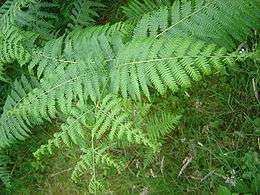Haumia-tiketike
| Haumia-tiketike | |
|---|---|
| Fernroot, uncultivated plants | |
| Other names | Haumia, Haumia-roa, Haumia-tikitiki |
| Gender | Male |
| Region | New Zealand |
| Ethnic group | Māori |
| Personal information | |
| Parents | Rangi and Papa (Arawa), or Tamanuiaraki (southern Kāi Tahu), or Tāne (southern Bay of Plenty and parts of the east coast) |
| Siblings | Ioiowhenua, Rehua, Urutengangana, Rongo, Tāne, Tangaroa, Tāwhirimātea, Tū, Rūaumoko Manuika, Manunuiakahoe, Huawaiwai, Tahitokuru, Kohurere, Teaohiawe, Haere, Uenukupokaia, Uenukuhorea , Rakiwhitikina, Te Pukitonga (Version dependant) |
In Māori mythology, Haumia-tiketike or Haumia (also Haumia-roa, and Haumia-tikitiki) is the god (atua) of the fernroot and uncultivated plants.[1] He is particularly associated with the starchy rhizome (aruhe) of the Pteridium esculentum[lower-alpha 1] (rarauhe), which became a major element of the Māori diet in former times.[2][3] He contrasts with his brother Rongo, the god of the kumara and all cultivated plants.
In different regional and tribal variations of the stories involving him, he is often a son or grandson of Rangi (Raki) and/or Papa.
Separation of the primordial parents
In the Arawa version of the origin story, Haumia was a son of Rangi and Papa, and agreed to the forced separation of his parents. Because of this he was subjected to the fury of his brother Tāwhirimātea, god of winds and storms, who would have killed him if their mother had not hidden him in her body, that is, in the ground. While he escaped from Tāwhirimātea, he was later discovered by Tū, god of war (here representing humankind), who saw Haumia's hair (bracken fronds) sticking up out of the earth[2] (Grey 1956:7-10, Orbell 1998:29, Tregear 1891:54).
Bracken

Food-quality rhizomes were only obtained from bracken growing in deep, moderately fertile soils. Bracken became abundant after the arrival of Māori, "mainly a result of burning to create open landscapes for access and ease of travel" (McGlone et al., 2005:1). Rhizomes were dug in early summer and dried for use in the winter. Although it was not liked as much as kumara, it was appreciated for its ready availability and the ease with which it could be stored (Orbell 1998:29).
The rhizomes were air-dried so that they could be stored and become lighter; for consumption, they were briefly heated and then softened with a patu aruhe (rhizome pounder); the starch could then be sucked from the fibres, or collected to be prepared for a larger feast. Several distinct styles of Patu aruhe were developed.
The plants of the bracken genus (Pteridium) contain the known carcinogen ptaquiloside,[4] identified to be responsible for haemorrhagic disease, as well as esophageal cancer, and gastric cancer in humans.
Genealogy
- Haumia is a son of Rangi and Papa, according to the tribes of the Arawa canoe.
- Elsdon Best noted that Haumia was not recognised as a son of Rangi and Papa by the tribes of the Tākitimu canoe.[2]
- In the southern Bay of Plenty and parts of the east coast, Haumia is a son of Tāne, who is the son of Rangi and Papa (Orbell 1998:29).
- In the southern Kāi Tahu version, Haumia is a son of Tamanuiaraki (Tama-nui-a-raki), who is a son of Raki and Hekehekeipapa (Hekeheke-i-papa) (White 1887-1891, I:20).
See also
Notes
- ↑ Elsdon Best in his book, Maori Religion and Mythology Part 1, wrote that the Māori ate the rhizomes of Pteris aquilina,[2] which is Pteridium aquilinum.
References
- ↑ "Māori Dictionary search results for 'Haumia-tiketike'". John C Moorfield. Retrieved 4 May 2018.
- 1 2 3 4 Elsdon Best (1924). Maori Religion and Mythology Part 1. Dominion Museum. p. 184.
- ↑ "Māori Dictionary search results for 'rarauhe'". John C Moorfield. Retrieved 4 May 2018.
- ↑ Fletcher M.T., Hayes P.Y., Somerville M.J., De Voss J.J."Ptesculentoside, a novel norsesquiterpene glucoside from the Australian bracken fern Pteridium esculentum". Tetrahedron Letters. 51 (15) (pp 1997-1999), 2010.
Bibliography
- G. Grey, Polynesian Mythology, Illustrated edition, reprinted 1976. (Whitcombe and Tombs: Christchurch), 1956.
- M. S. McGlone, J. M. Wilmshurst, and Helen M. Leach, 'An ecological and historical review of bracken (Pteridium esculentum) in New Zealand, and its cultural significance' New Zealand Journal of Ecology (2005) 29(2): 165–184.
- M. Orbell, The Concise Encyclopedia of Māori Myth and Legend (Canterbury University Press: Christchurch), 1998.
- E. R. Tregear, Maori-Polynesian Comparative Dictionary (Lyon and Blair: Lambton Quay), 1891.
- J. White, The Ancient History of the Maori, 6 Volumes (Government Printer: Wellington), 1887-1891.